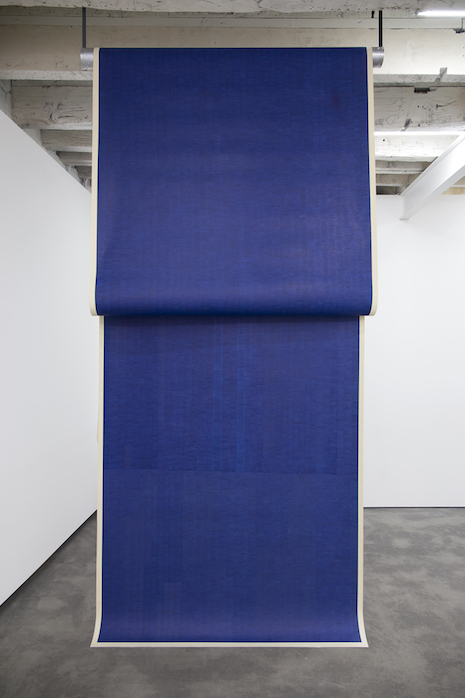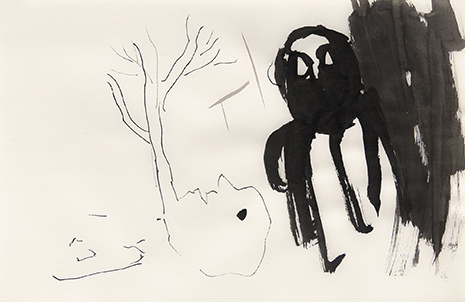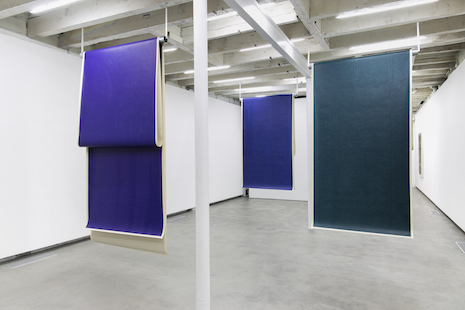In the wake of her recent exhibition “Late October” at On Stellar Rays in the Lower East Side, Katy Diamond Hamer sat down with artist Zipora Fried. Their dialogue which is below, confronts the visual language that Fried utilizes in her large-scale drawings. Her draughtsmanship, with markings similar to that of the written word, oscillates across the expanse of unfurled paper and say much about time, space and artistic desire with nary an actual word to be found. Walking a fine line between abstraction and minimalism, Fried who was born in Israel but is based in New York, uses layering as a way to complete detach from semiotics. Her gestures are completely precision driven and while her choice in mediums may vary her visual dialogue often revolves around repetition and accumulation.
Katy Diamond Hamer: What initially inspired you to make the labor intensive drawings that were on view in “Late October”?
Zipora Fried: This is not an idea that came to me over night. It is a lifelong practice that has been accumulating over many years. There is no direct inspiration for the work as it’s developed and expanded over many years. This particular body of work and its presentation at On Stellar Rays is the most ambitious project I have embarked on so far. This [type of] practice goes way back for me because as a child drawing was a way for me to avoid communication. I was known as “the girl who doesn’t talk and doesn’t smile”. Even at the Academy in Vienna when I was an art student my professor who didn’t bother remembering his students’ names referred to me as the “blue eyed girl who doesn’t talk”. My schoolbooks where full of drawings and I drew on the walls of my room. I was quiet yet observant, hungry for visual stimulation, not interested in words. Form in my drawings became less important over the years, the rhythm and the stroke much more so. The process [of making these large-scale drawings] has an overall effect that seems woven and stands out in stark contrast to the monumental appearance of each piece. I can look back at the work I produced and see a visible result through drawing, of my efforts. The first works in this series were made with a graphite pencil, creating a negative space and concentrating on scale and proportion. They were presented for the first time 2006 on the floor of a gallery in Brussels and later in a museum in Vienna. In Vienna they were presented [off the floor and] on large, low to the ground pedestals, discouraging visitors from stepping on them and dogs from peeing on them. The installation didn’t really protect the drawings though and one night the A/C unit above had a problem and a flood of water came down onto one of them.

Zipora Fried, All I Thought and Forgot #2 (delft blue), 2016
Colored pencil on paper, 312 by 53-1/2 inches, Courtesy of On Stellar Rays, NY, 2016
KDH: That must have been very stressful but I’m sure encouraged you to continuously seek out new forms of installation techniques.
ZF: Exactly, the works in my most recent show, from the series “All I Thought and Forgot,” are made with colored pencils and were hanging from rods on the ceiling. Initially the purpose of the oversized graphite drawings was to move the medium of drawing to a sculptural, monumental realm and exceed the boundaries and characteristics of drawing. Adding color to this practice creates an almost painterly, narrative appearance. The awareness of the maddening effort involved in making these works evokes a strangely emotional response. They tell a silent story intrinsically linked to the consciousness that created them; massive, but extremely vulnerable.
KDH: How do you see the relationship between the drawings and your sculptural work. Is there one?
ZP: There is a purely conceptual relationship between the sculptures and the large-scale drawings. I aim to deprive objects of their functionality and their known behaviors and by doing so I give them a new dysfunctional existence. Transformation and manipulation of materials initiates us to redraw patterns of meaning, thinking that recalls and responds creates new thought and at the same time new confusion. With this installation I wanted to move the drawing further away from the drawing board, pushing the 3-Dimensional aspect while also obscuring certain areas. Joseph Beuys stated,
Man is really not freeing many aspects. He is dependent on his social circumstances, but he is free in his thinking, and here is the point of origin of sculpture. For me the formation of the thought is already sculpture. The thought is sculpture.
KDH: In the back room of the gallery, you exhibited a series of more intimate, smaller drawings. They seem to be works that allow you a mental break from the monotony of the large-scale works. Is this true?
ZF: The ink drawings are a more direct, narrative expression. The figurative imagery of these works is inspired by Japanese Yōkai stories. They are disquieting, explosive instances inhabited by shape-shifting animated creatures. The stories provide never-ending possibilities for fear based fantasy, providing a glimpse into the unfamiliar. They explore a common subconscious and its cruel and immature dark corners. Yes, these come from a different place than the large-scale works. The making of the large pencil drawings is a practice that involves weeks and weeks of monotony. The only way to get through this process and not lose my mind is to be completely in the moment and focus on the lines as they appear – you cannot think back and you cannot think ahead. It’s like running a marathon. The smaller ink drawings provide immediate results. My practice is multidisciplinary – some series and techniques phase out and may come back later, others are discontinue and just serve the purpose of discovery. I refuse to limit my practice to just one way of examining and trying to understand life and the “social organism” we live in.

Zipora Fried, All I Thought and Forgot #3 (deep cobalt green), 2016
Colored pencil on paper, 312 by 53-1/2 inches, Courtesy of On Stellar Rays, NY, 2016
KDH: Initially you didn’t want to address the colors present in “Late October” which are bold, highly-saturated, cool tones. Yet, they seem very relevant and specific. Can you offer any insight into your decision to use these particular tones?
ZF: A few years ago I made a series of mid-size drawings in *Delft blue. The intense color of the Delft blue pigment is very similar to a natural Ultramarine pigment made from ground Lapis lazuli. [At the time] I used Ultramarine as well as with Delft blue. While they are very similar in tone, Delft blue stood out as the more complex color. Initially, four of the large-scale drawings –each 30 feet in length– I completed in the past were made with a graphite pencil and I didn’t plan to make any colored works at this size. However, I thought Delft blue would be quite strong in the exhibition space [at On Stellar Rays]. This color has always stayed in my mind as a color that needs further exploration so was my first choice for “All I Thought and Forgot #2”. The second blue was selected once the Delft blue piece was completed. I was looking for a very typical blue with a less dominant presence. I wanted these two to be installed close to each other – the extroverted Delft blue in dialogue with the more pensive Helioblue. The third drawing in Deep Cobalt green contains a blue pigment mixture. Green is lacking any undertone of joy, grief, or passion therefore It seemed to me to be the best color to round-up the experience.
*Editor’s note: Delft blue originated in Holland in the 16th century and was used in tin-glazed earthenware, Delftware.
“Late October” was on view at On Stellar Rays from October 23rd and originally slated to close December 4th but extended through December 11th, 2016. Fried’s work will be on view upcoming at Zona Maco in Mexico City February 8th through 12th with On Stellar Rays.

Zipora Fried, Untitled from the Barbara series, 2016
Ink on paper, Courtesy of On Stellar Rays, NY, 2016
Katy Diamond Hamer is the Founding Editor in Chief of Eyes Towards the Dove. She has been writing on contemporary art and culture since 2007. For more, follow her on Instagram @katyhamer

